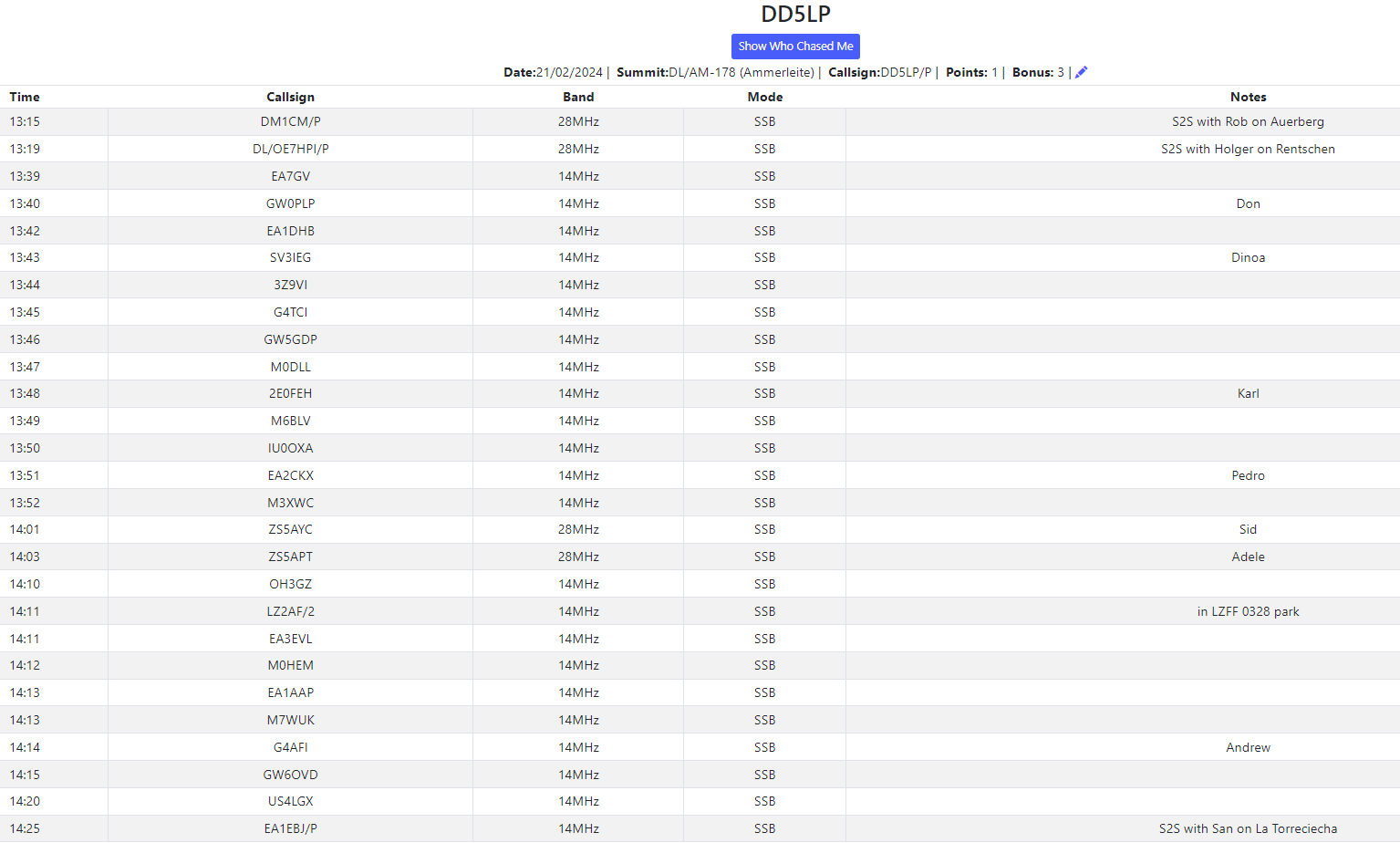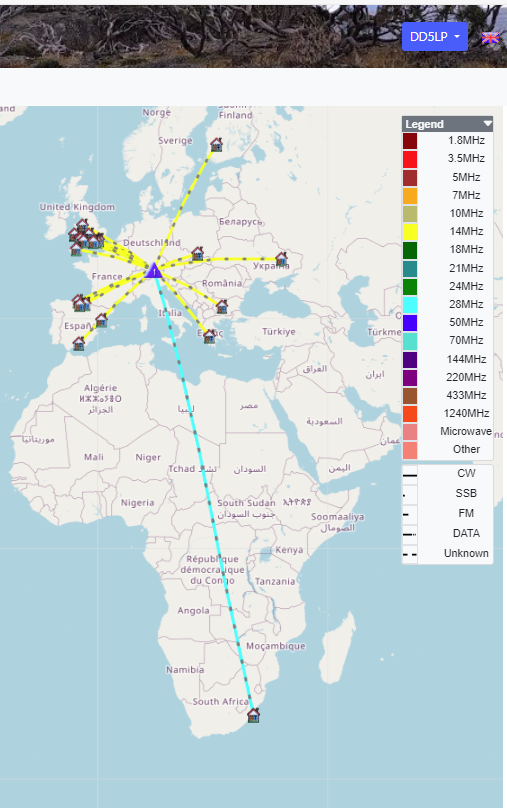Preparation:
This was to be another test of the beam antenna to take advantage of good propagation and terrestrial weather conditions and while I wanted to try to get some contacts into North America, this would be an afternoon activation rather than my usual early morning ones.
The equipment would be the same as the last time (no tripod) but this time also no antenna analyser, I am confident enough now that, as long as I connect everything up correctly, the antenna will be resonant on 20m and 10m.
As I wasn’t sure of the 10m performance of the trapped antenna variant the last time that I was out, I also packed the non-trapped 10m elements for the antenna. As I have not got a small plastic case where I can pack the beam, both the manually switched and the non-switched feed plates would be taken along.
The Activation
DL/AM-178 Ammerleite
An afternoon activation means that I have time to pack equipment in the car, have my lunch and then travel down to the summit (about a 45-minute drive). I was expecting a muddy track to the summit, but it wasn’t too bad. The main thing was that it was not raining or windy and in fact the sun had actually come out!
As I arrived two walkers were just leaving, so I had the whole area around the cross to decide where I would set the antenna up and which of the two seat benches, I would activate from.
Setting up the antenna has now become routine and the biggest issue is trying the get the screw-in base support fairly near to vertical (I still need more practice at this, as you will see from the photos).
The fact that the antenna has 4 support cords (the antenna elements plus their extender cords) makes the mast/antenna more stable than when just using a dipole.
Once the antenna was set up, I ran the coax back to the bench and set up the radio. I decided to start on 10 metres, as I could see some other activators were already on the band.
The first contact in the log was Rob DM1CM out on Auerberg, so a local Summit-2-Summit contact. He had been on two summits and had started in the morning. The second contact was a call from Holger operating as DL/OE7HPI from another local summit – Rentschen, so there was another S2S contact. This was a good start to the activation but contacts quickly dried up and I found that 10 metres sounded rather quiet when there was no signal present. This started me wondering whether this was a problem with the new antenna or perhaps the radio.
In any case, I decided to switch to 20 metres to see what was happening there and I got a stream of thirteen contacts from around Europe until that seemed to dry up. So I used this time to test the antenna while pointing west initially on some relatively strong signals that I found on the band, I turned the antenna from West to South, to North and back to West – each time needing me to lower the mast, turn the switch and raise the mast again and then wait for the monitored station to come on again. the results I got were the same as at Rösenau Kreuz. Turning the antenna away from the direction of a signal, dropped the signal 1 S-point when side on and 2 S-points when back-on to the station. This (rough) measurement tallies what the antenna models say.
I then switched the radio back to 10 metres again (this is the advantage of having a trapped antenna, that I don’t need to do anything at the antenna when I change between the supported bands). Just tuning around, I found another SOTA activator who was very weak but was being worked by Sid ZS5AYC out of South Africa. This was the other activator’s frequency so I could not call in, so instead, I switched the antenna to radiate to the South, found a free frequency about 5 kHz higher, spotted myself and started calling CQ. After a couple of minutes – Sid called me, so that contact with Sid and his wife Adele ZS5APT were to be my longest contacts for the day. It was interesting to hear a warbling sound on the signals – which I put down to the Trans Equatorial Propagation.
After getting those two DX contacts in the log, I tried calling CQ on 10 metres for a while but got no takers. I even tried calling a loud US station, who was calling specifically for low power stations but unfortunately, all the callers I heard, I know have high power stations and hence I and probably most other low power stations could not get through.
I decided to move back onto 20m to at least “reserve” my frequency for a sked I had set up with Caryn KD2GUT who was out in a POTA park on Long Island New York. I got another 10 contacts on 20m into the log but unfortunately, none of those were Caryn – I “think” I heard her voice once, deep in the noise but I’m not sure and it wasn’t long before some QRO station decided to sit 2 kHz off the frequency and splatter all of the frequency making any further attempts at the POTA to SOTA contact futile.
The afternoon was getting closer to dusk and the sun had gone, so I decided to “call it a day” and pack up. I was just finished packing up when a local, walking his dog arrived, so I left him the area – I suspect he might have been there to await the sunset.
Photos:
DL/AM-178 Ammerleite:
Equipment taken:
- Mountaintop travelling 40-litre rucksack.
- Xiegu G90 radio.
- Screw-in sun umbrella base.
- 7 metre fibreglass mast.
- 10-metre band 2-element wire beam (manual switch version).
- Komunica Power HF-Pro2-PLUS-T loaded vertical antenna and tripod (not used)
- Lamdahalbe 6m mini-mast (not used).
- SOTABeams Linked Dipole (not used).
- 4 Ah Eremit LifePO4 battery.
- 4 Ah LiHV battery(not used).
- Painter’s thick plastic sheet (not used).
- Gardener’s kneeling pad (not used).
- Electrical hand warmer(not used).
- Lightweight headphones.
- Smartphone for SOTA spotting.
Log:
DL/AM-178 Ammerleite
Contacts map
Conclusions:
-
The wire beam antenna worked well with between 1 & 2 S-points difference on weak signals depending upon the direction it was switched.
-
Once I got home, I tried the G90 radio on the main antenna and while it was a lot more “active” than when out on the summit another point I had seen while out – that turning off AGC completely, had no effect on signals -was still there. So it looks like the “quiet 10 metres” is down to the radio more than the antenna. I then went into the settings and changed the RF gain from 50% to 72% and it made all the difference on 10 metres, the band sounded better and turning off the AGC had the expected effect of “boosting” weak signals. So I’ll be leaving the RF gain at 72% now. Unfortunately RF gain is one control which applies to all bands, there is not a separate setting for each band, which would be nice.
73 ’til the next summit.



You must be logged in to post a comment.